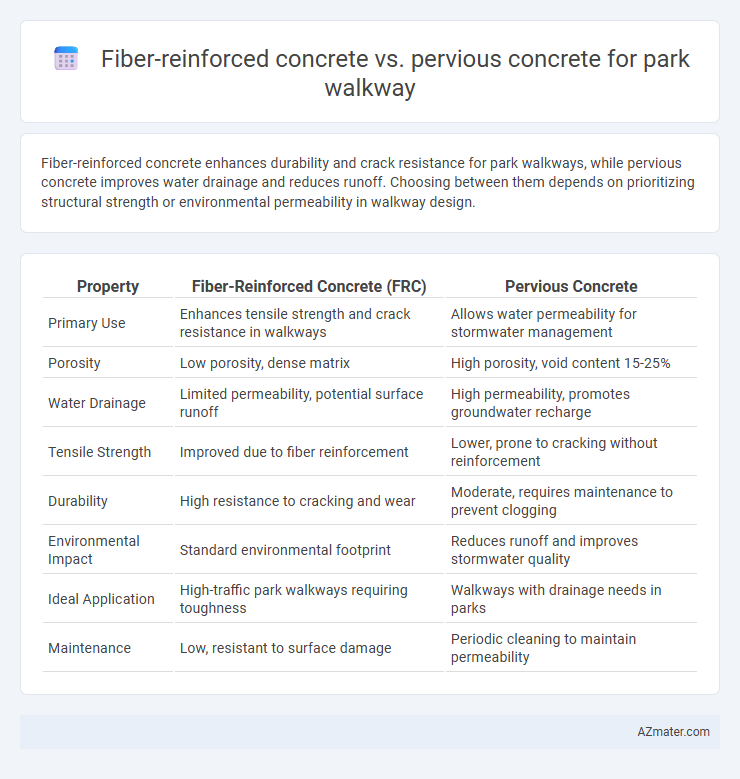Fiber-reinforced concrete enhances durability and crack resistance for park walkways, while pervious concrete improves water drainage and reduces runoff. Choosing between them depends on prioritizing structural strength or environmental permeability in walkway design.
Table of Comparison
| Property | Fiber-Reinforced Concrete (FRC) | Pervious Concrete |
|---|---|---|
| Primary Use | Enhances tensile strength and crack resistance in walkways | Allows water permeability for stormwater management |
| Porosity | Low porosity, dense matrix | High porosity, void content 15-25% |
| Water Drainage | Limited permeability, potential surface runoff | High permeability, promotes groundwater recharge |
| Tensile Strength | Improved due to fiber reinforcement | Lower, prone to cracking without reinforcement |
| Durability | High resistance to cracking and wear | Moderate, requires maintenance to prevent clogging |
| Environmental Impact | Standard environmental footprint | Reduces runoff and improves stormwater quality |
| Ideal Application | High-traffic park walkways requiring toughness | Walkways with drainage needs in parks |
| Maintenance | Low, resistant to surface damage | Periodic cleaning to maintain permeability |
Introduction to Concrete Solutions for Park Walkways
Fiber-reinforced concrete enhances durability and crack resistance in park walkways by incorporating synthetic or steel fibers, making it ideal for heavy foot traffic and long-term maintenance reduction. Pervious concrete improves stormwater management through its porous structure, allowing water to pass through and reducing runoff, which supports sustainable park environments. Selecting the appropriate concrete solution depends on balancing structural strength with environmental considerations, ensuring safe and eco-friendly park walkways.
What is Fiber-Reinforced Concrete?
Fiber-reinforced concrete (FRC) is a composite material that incorporates fibrous substances, such as steel, glass, synthetic, or natural fibers, to enhance the structural strength and durability of concrete used in park walkways. It improves crack resistance, reduces shrinkage, and increases impact and abrasion resistance, making it ideal for high-traffic pedestrian areas. Compared to pervious concrete, FRC provides superior load-bearing capacity and longevity, while maintaining a smoother, more stable walking surface.
What is Pervious Concrete?
Pervious concrete is a porous material designed to allow water to pass through, reducing surface runoff and promoting groundwater recharge, making it ideal for park walkways requiring effective stormwater management. Unlike fiber-reinforced concrete, which enhances strength and durability by incorporating fibers, pervious concrete prioritizes permeability and environmental benefits. Its open-void structure typically achieves porosity levels between 15% and 25%, facilitating rapid drainage and minimizing puddling in outdoor recreational areas.
Key Performance Differences: Strength and Durability
Fiber-reinforced concrete exhibits superior tensile strength and crack resistance compared to pervious concrete, making it ideal for park walkways subject to heavy foot traffic and load variations. Pervious concrete prioritizes permeability and stormwater management but has lower compressive strength and durability under mechanical stress. Choosing between the two depends on balancing structural integrity with environmental benefits for sustainable park infrastructure.
Permeability and Water Management Capabilities
Fiber-reinforced concrete offers enhanced structural strength and crack resistance but has limited permeability, making it less effective for water drainage in park walkways. Pervious concrete excels in permeability with its porous structure, allowing efficient water infiltration and reducing surface runoff, which supports sustainable water management. Selecting pervious concrete for park walkways optimizes stormwater drainage and promotes groundwater recharge while maintaining adequate load-bearing capacity.
Maintenance Requirements and Lifespan
Fiber-reinforced concrete offers enhanced durability and reduced cracking, leading to lower maintenance requirements compared to pervious concrete, which often requires regular cleaning to prevent clogging of its porous structure. The lifespan of fiber-reinforced concrete typically exceeds 30 years under normal conditions, while pervious concrete may have a shorter lifespan of 15 to 20 years due to susceptibility to freeze-thaw cycles and clogging. Proper maintenance of pervious concrete involves periodic vacuuming or pressure washing to maintain permeability and structural integrity for pedestrian park walkways.
Environmental Impact and Sustainability
Fiber-reinforced concrete significantly enhances durability and reduces maintenance frequency, lowering overall environmental impact through extended lifespan and less material consumption. Pervious concrete contributes to sustainable urban drainage by facilitating groundwater recharge and reducing stormwater runoff, improving local water quality and mitigating heat island effects. Choosing between the two depends on balancing the need for structural resilience with ecological benefits in park walkway design.
Cost Analysis and Installation Methods
Fiber-reinforced concrete offers enhanced durability and lower maintenance costs for park walkways due to its resistance to cracking and wear. Pervious concrete, while generally more expensive initially due to specialized mixing and installation techniques, provides superior stormwater management by allowing water infiltration. Installation of fiber-reinforced concrete involves conventional pouring methods with added fiber integration, whereas pervious concrete requires careful compaction and curing to maintain its porous structure, influencing labor costs and project timelines.
User Comfort and Safety Considerations
Fiber-reinforced concrete offers enhanced durability and crack resistance, providing a smoother and safer surface for park walkways by reducing trip hazards. Pervious concrete improves drainage and reduces surface water accumulation, minimizing slipping risks in wet conditions and contributing to user comfort. Both materials enhance safety, but fiber-reinforced concrete delivers greater structural integrity, while pervious concrete excels in water management for walkways.
Choosing the Best Concrete Option for Park Walkways
Fiber-reinforced concrete offers enhanced durability and crack resistance, making it ideal for high-traffic park walkways requiring long-lasting performance. Pervious concrete provides excellent water permeability, promoting stormwater management and reducing runoff, which is beneficial for sustainable park designs. Selecting the best concrete option depends on balancing durability needs with environmental impact and maintenance preferences in the park's specific context.

Infographic: Fiber-reinforced concrete vs Pervious concrete for Park walkway
 azmater.com
azmater.com